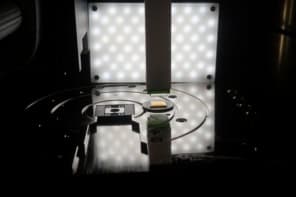
The best glimpse yet of electrons moving in a magnetic field has revealed that the particles’ behaviour differs strongly from what is predicted by classical physics but is consistent with quantum-mechanical theory. Instead of rotating uniformly at a particular frequency, an international team of researchers has found that electrons in a magnetic field are capable of rotating at three different frequencies, depending on their quantum properties.
Cyclonic movements
Little is known about the behaviour of electrons in a magnetic field and scientists are keen to improve our understanding of the physical processes that are involved. Free-electron Landau states are a form of quantized state adopted by electrons moving through a magnetic field. All charged particles interact with electromagnetic fields via the Lorentz force. This interaction causes electrons in a magnetic field to move in a corkscrew pattern. “Landau states can be envisaged as vortices occurring naturally in the presence of magnetic fields. The magnetic field plays the same role for electrons as the Earth’s rotation plays for the creation of cyclones, but on a much smaller scale,” says Peter Schattschneider of the Institute of Solid State Physics at the Vienna University of Technology, who is part of an international team that includes researchers from France, Japan and the US that has now devised a way to reconstruct these states.
According to classical physics, electrons should rotate about the magnetic-field direction with a single frequency, called the “cyclotron frequency”. But in their experiments, the researchers found that, contrary to what was predicted, they were able to induce a multitude of rotation frequencies in their moving electrons, namely the cyclotron frequency, zero frequency and the Larmor frequency (which is half the cyclotron frequency).
Vortex beams
The team did not observe the electrons’ Landau states directly. Rather, the researchers used a transmission electron microscope to create so-called electron vortex beams, which can be shaped so that their rotational behaviours closely resemble Landau states. “In an electron vortex beam, electrons are swirling around a common centre similar to air molecules in a tornado. Typically, this bunch of whirling electrons is also moving along its axis of rotation, thereby moving along a spiral path,” says Schattschneider.
The team used the microscope’s focusing lenses to reconfigure the electron vortex beams so that these matched the size of the Landau states. Schattschneider compares the task of determining the rotation of the electrons to figuring out how many times a thin wire is wound around a rod. “When looking at the wire directly, it is extremely difficult to count the number of windings. But when it is stretched along the direction of the rod, the wire takes the form of a well-spaced spiral, for which it is easy to count the revolutions,” he says. “This is precisely what we did with the Landau states: we ‘elongated’ them to vortex beams. That way we could measure [their frequencies] with very high accuracy.”
“This is a very exciting finding, and it will contribute to a better understanding of the fundamental quantum features of electrons in magnetic fields,” says Franco Nori of the RIKEN Centre for Emergent Matter Science in Japan, who led the research. In addition to showing that the rotational dynamics of the electrons are more complex and intriguing than was once believed, the new findings could have practical implications for technology, according to the researchers.
Jo Verbeeck of the University of Antwerpen in Belgium believes that the quantum effects of electrons revealed in the new study are “thought-provoking”. “What is interesting now is that the authors succeeded in taking these Landau states into free space, away from the material in which they normally manifest themselves, in order to better study the peculiarity of their motion,” says Verbeeck, who was not involved in the study.
“We hope that this will lead to new insights and a better understanding of the delicate interaction between magnetic fields and matter, which might one day give rise to new and better technologies such as sensors and memmory devices,” Schattschneider says.
The research is published in Nature Communications.



